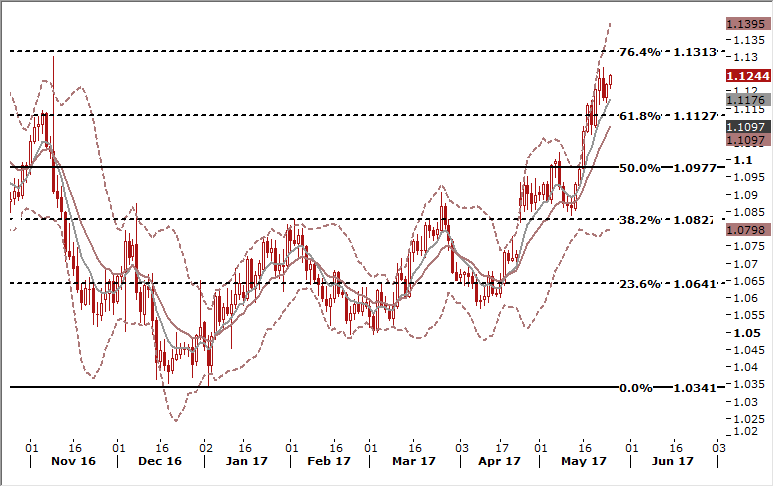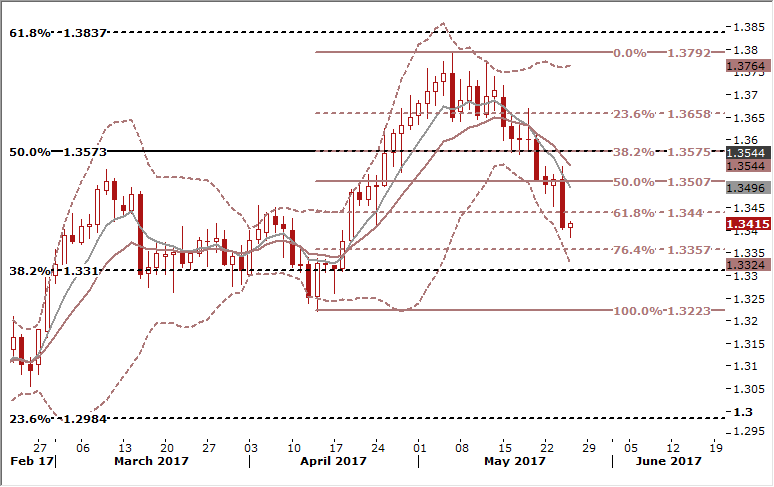EUR/USD: Fed ties further rate hikes to economic rebound
Macroeconomic overview: U.S. Federal Reserve policymakers agreed they should hold off on raising interest rates until they see evidence that a recent economic slowdown was transitory, minutes from their last policy meeting showed on Wednesday.
Nearly all policymakers at the May 2-3 meeting also said they favored starting the wind-down of the Fed's massive holdings of Treasury debt and mortgage-backed securities this year.
U.S. economic growth slowed sharply in the first quarter, and the wider group of 16 policymakers at this month's meeting discussed at length why that had happened and why a measure of underlying price gains also fell further below their 2% inflation target.
Many of these policymakers said recent firming of the housing market and business fixed investment were welcome developments, and they generally agreed the slowdown in consumer spending early in the year would likely prove temporary.
The discussion of winding down the Fed's balance sheet was also framed in the minutes in terms of the wider group of policymakers. They said it could possibly be done by halting reinvestments of ever-larger amounts of maturing securities, such as through bigger cuts to reinvestments every three months.
U.S. home resales fell from a more than 10-year high in April, weighed down by a chronic shortage of houses on the market that is keeping prices elevated and sidelining prospective buyers. Despite the stumble, the housing market remains on solid ground as the labor market nears full employment, which is expected to spur faster wage growth.
The National Association of Realtors said on Wednesday existing home sales declined 2.3% to a seasonally adjusted annual rate of 5.57 million units last month. Sales scaled a 5.70 million-unit pace in March, which was the highest level since February 2007.
Though the drop in sales was worse than market expectations for a 1.1% decrease, April's sales pace was the fourth highest over the past 12 months. Sales were up 1.6% from April 2016, also underscoring the housing market's underlying strength.
There were 1.93 million houses on the market last month. While that was a 7.2% increase from March, supply was down 9.0% from a year ago. Housing inventory has dropped for 23 straight months on a year-on-year basis.
With recent data showing a drop in homebuilding and a plunge in new home sales in April, weak home resales suggest residential investment will probably make a small contribution to GDP in the second quarter. Housing added half a percentage point to the economy's 0.7% annualized growth pace in the first quarter.
European Central Bank President Mario Draghi said the side-effects of the ECB's unconventional policy tools have remained "contained", so there is no reason to deviate from the policy path already laid down by the ECB.
Technical analysis: Despite strengthening signals of a corrective move, the EUR/USD resumes its rise. The pair bounced from 7-day exponential moving average yesterday, but is still below May 23 high at 1.1267. Slow stochs are unwinding from an overbought bias and there is still a risk of corrective action in the coming days. 
USD/CAD slides after not-so-dovish BoC, eyes on OPEC now
Macroeconomic overview: The Bank of Canada held interest rates steady, as expected, saying that while economic growth was likely to moderate in the second quarter, government measures to rein in the housing market have not yet had a substantial effect.
Fearful of a housing bubble, the federal government has tightened mortgage lending rules while provincial governments have imposed taxes on foreign buyers in Vancouver and Toronto.
Bank of Canada Governor Stephen Poloz has previously said gains in home prices in those cities are unsustainable, and speculation was probably a factor. Household debt compared with income is at a record high.
In a statement seen as less dovish than some had expected, the central bank said excess capacity remains in the economy and wage growth is subdued but noted strong spending by Canadians along with a housing boom and job growth. However, the BoC dropped the word “material” when they talked about excess capacity.
The bank said Canada's exporters still face "competitiveness challenges" and uncertainties remain but that recent indicators of business investment were encouraging. Poloz has said U.S. trade protectionism is the biggest cloud on the horizon for Canada, which sends some 75% of its exports to the United States.
OPEC and non-member oil producers are gearing up to extend output cuts today, possibly by as long as 12 months, to help clear a global stocks overhang and prop up crude prices. Most OPEC ministers, delegates and the market see a nine-month extension - instead of the initially suggested six months - as the base-case scenario but some countries including Russia have suggested an unusually long duration of 12 months. However, a decision on deeper output cuts is unlikely today.
Technical analysis: The loonie continues its rally. The USD/CAD closed below 61.8% fibo of April-May rise at 1.3440, which is the nearest resistance level now.Our medium-term view remains bearish and our trading strategy is to sell on upticks. 
Source: GrowthAces.com - your daily forex trading strategies newsletter
